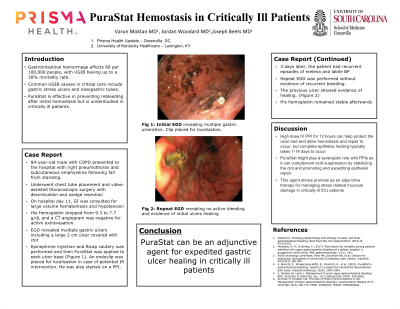Tuesday Poster Session
Category: GI Bleeding
P4246 - Purastat Hemostasis in Critically Ill Patients
Tuesday, October 29, 2024
10:30 AM - 4:00 PM ET
Location: Exhibit Hall E

Has Audio
- VM
Varun Moktan, MD
Prisma Health, University of South Carolina School of Medicine
Greenville, SC
Presenting Author(s)
Varun Moktan, MD1, Jordan Woodard, MD2, Joseph Beets, MD3
1Prisma Health, University of South Carolina School of Medicine, Greenville, SC; 2University of Kentucky College of Medicine, Lexington, KY; 3Prisma Health Greenville Memorial Hospital, Greenville, SC
Introduction: Gastrointestinal hemorrhage is a common condition occurring in at least 80 out of 100,000 people with upper gastrointestinal bleeding (UGIB) being most common. The mortality rate is reported up to 30% within 60 days of an UGIB. In the critical care setting, a common source for UGIB include gastric stress induced ulcers or from indwelling nasogastric tubes. PuraStat is a topical therapy approved for management of acute gastrointestinal bleeding. Hemostasis with PuraStat as the initial therapy has shown absence of rebleeding. However, these studies have not addressed this therapy’s role in critically ill patients who have prolonged hospitalizations and are at risk for other ulcer induced processes.
Case Description/Methods: An 84-year-old male with past medical history of chronic obstructive pulmonary disease, hypertension, and coronary artery disease presented initially presented to the hospital with right pneumothorax and subcutaneous emphysema following fall from standing. He ultimately required chest tube placement and video-assisted thoracoscopic surgery with decortication and wedge resection.
On hospital day 11 he had hypotension following a large volume hematemesis for which gastroenterology was consulted. Hemoglobin dropped from 9.3 to 7.7 g/dL. Nasogastric tube was placed with minimal output to suction. A CT angiogram was negative for extravasation. He received 3 units packed red blood cells, IV pantoprazole twice daily, and was intubated for bedside EGD. Multiple gastric ulcers were visualized including a large 2 cm ulcer covered with clot. Epinephrine injection and bicap cautery was performed and then PuraStat was applied to each ulcer base (Figure 1). An endoclip was placed for localization in the event interventional radiology was needed.
3 days later, the patient had recurrent episodes of melena with labile blood pressures. Repeat EGD was performed without evidence of recurrent bleeding. The previous looked improved with evidence of healing. (Figure 2).
Discussion: UGIB is a common complication of critically ill patients in the hospital. Our patient represents management of UGIB with PuraStat and provides post-intervention visualization of the healing achieved following PuraStat. The combination of PuraStat with cautery proves to be successful in hemostatic control in patients with UGIB especially those at risk for both nasogastric as well as stress induced ulcers.

Disclosures:
Varun Moktan, MD1, Jordan Woodard, MD2, Joseph Beets, MD3. P4246 - Purastat Hemostasis in Critically Ill Patients, ACG 2024 Annual Scientific Meeting Abstracts. Philadelphia, PA: American College of Gastroenterology.
1Prisma Health, University of South Carolina School of Medicine, Greenville, SC; 2University of Kentucky College of Medicine, Lexington, KY; 3Prisma Health Greenville Memorial Hospital, Greenville, SC
Introduction: Gastrointestinal hemorrhage is a common condition occurring in at least 80 out of 100,000 people with upper gastrointestinal bleeding (UGIB) being most common. The mortality rate is reported up to 30% within 60 days of an UGIB. In the critical care setting, a common source for UGIB include gastric stress induced ulcers or from indwelling nasogastric tubes. PuraStat is a topical therapy approved for management of acute gastrointestinal bleeding. Hemostasis with PuraStat as the initial therapy has shown absence of rebleeding. However, these studies have not addressed this therapy’s role in critically ill patients who have prolonged hospitalizations and are at risk for other ulcer induced processes.
Case Description/Methods: An 84-year-old male with past medical history of chronic obstructive pulmonary disease, hypertension, and coronary artery disease presented initially presented to the hospital with right pneumothorax and subcutaneous emphysema following fall from standing. He ultimately required chest tube placement and video-assisted thoracoscopic surgery with decortication and wedge resection.
On hospital day 11 he had hypotension following a large volume hematemesis for which gastroenterology was consulted. Hemoglobin dropped from 9.3 to 7.7 g/dL. Nasogastric tube was placed with minimal output to suction. A CT angiogram was negative for extravasation. He received 3 units packed red blood cells, IV pantoprazole twice daily, and was intubated for bedside EGD. Multiple gastric ulcers were visualized including a large 2 cm ulcer covered with clot. Epinephrine injection and bicap cautery was performed and then PuraStat was applied to each ulcer base (Figure 1). An endoclip was placed for localization in the event interventional radiology was needed.
3 days later, the patient had recurrent episodes of melena with labile blood pressures. Repeat EGD was performed without evidence of recurrent bleeding. The previous looked improved with evidence of healing. (Figure 2).
Discussion: UGIB is a common complication of critically ill patients in the hospital. Our patient represents management of UGIB with PuraStat and provides post-intervention visualization of the healing achieved following PuraStat. The combination of PuraStat with cautery proves to be successful in hemostatic control in patients with UGIB especially those at risk for both nasogastric as well as stress induced ulcers.

Figure: 1. Initial EGD with Gastric Ulcer
2. Repeat EGD with evidence of granulation tissue and healing after PuraStat
2. Repeat EGD with evidence of granulation tissue and healing after PuraStat
Disclosures:
Varun Moktan indicated no relevant financial relationships.
Jordan Woodard indicated no relevant financial relationships.
Joseph Beets indicated no relevant financial relationships.
Varun Moktan, MD1, Jordan Woodard, MD2, Joseph Beets, MD3. P4246 - Purastat Hemostasis in Critically Ill Patients, ACG 2024 Annual Scientific Meeting Abstracts. Philadelphia, PA: American College of Gastroenterology.
